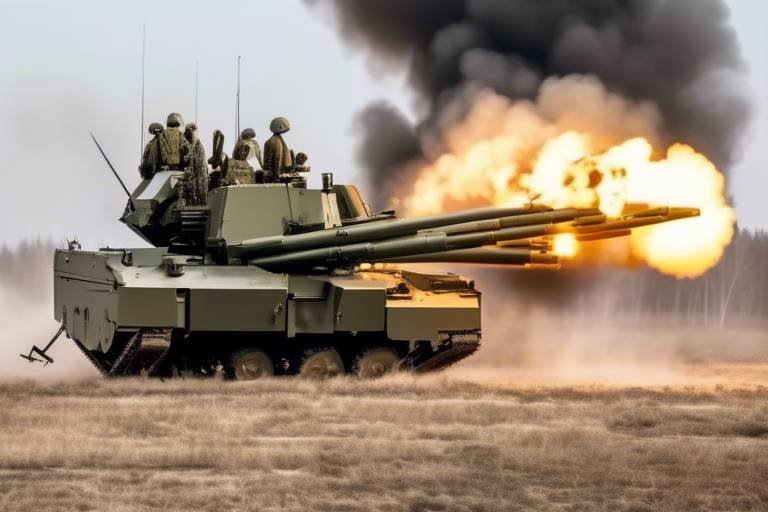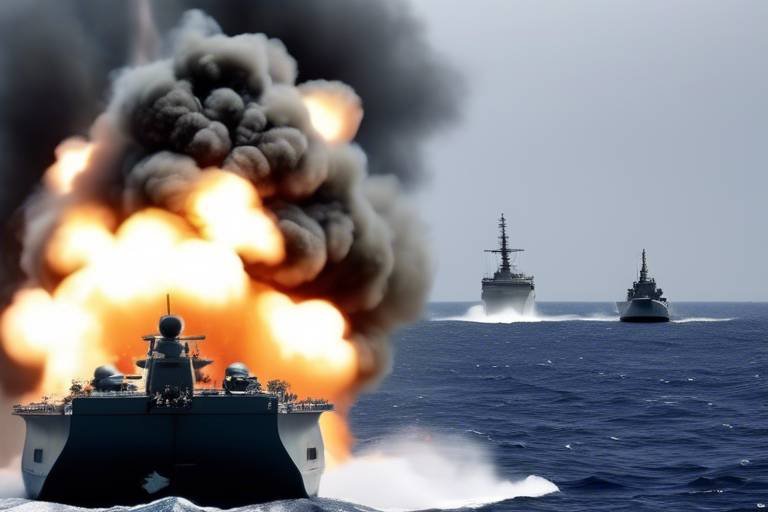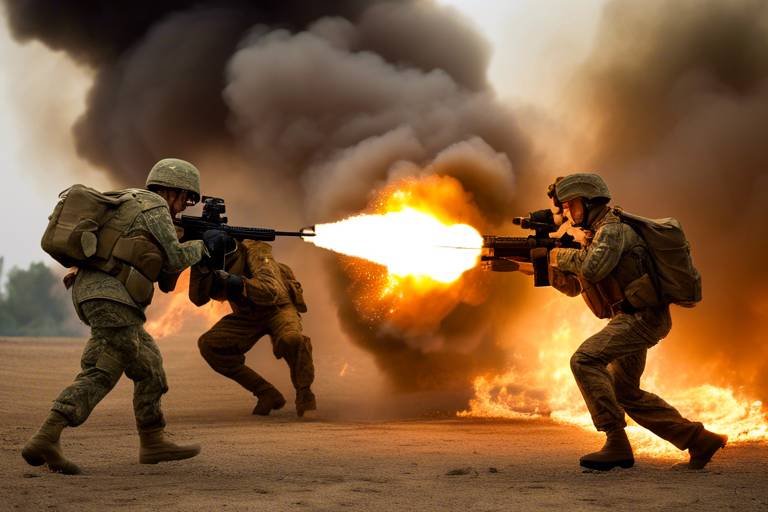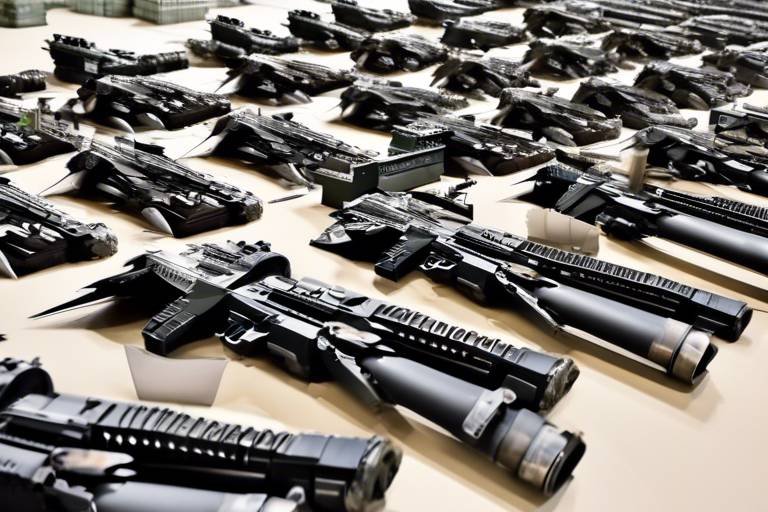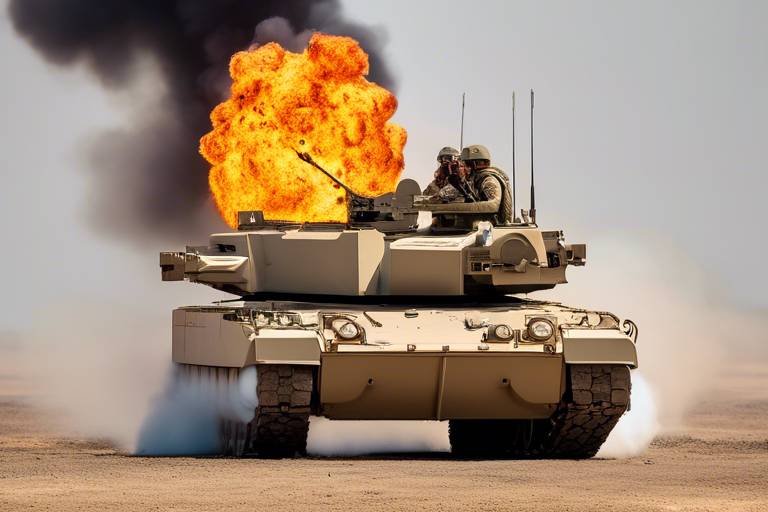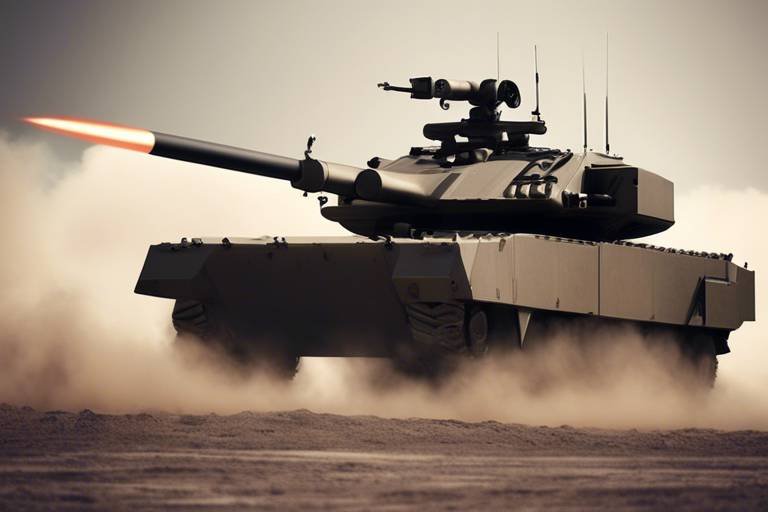How Artillery Systems Are Adapted for Asymmetric Warfare
In the ever-evolving landscape of modern combat, the dynamics of warfare have shifted dramatically, particularly with the rise of asymmetric warfare. This type of conflict, characterized by a stark imbalance in military capabilities between opposing forces, has forced traditional military strategies to adapt and innovate. Artillery systems, once the primary backbone of conventional warfare, have undergone significant transformations to meet the challenges posed by asymmetric engagements. In this article, we will delve into how these artillery systems have been tailored to enhance their effectiveness in such complex scenarios.
Asymmetric warfare often involves a smaller, less equipped force facing a larger, more sophisticated military. Think of it like a David versus Goliath scenario, where the underdog employs unconventional tactics to level the playing field. This has profound implications for artillery systems, which must be designed not just for power but also for precision and adaptability. The traditional image of artillery as a static, heavy weapon system is rapidly changing; modern artillery units must be capable of responding quickly to fluid battlefield conditions, often with little warning.
Historically, artillery has played a pivotal role in warfare, providing long-range firepower that could change the tide of battle. However, the historical context reveals that as conflicts evolved, so too did the technology and strategies behind artillery deployment. From the cannonades of the Napoleonic Wars to the howitzers of the World Wars, each era brought advancements that shaped modern artillery systems. Today, these systems are not merely about delivering explosive payloads; they are integrated with advanced technology that allows for precision strikes and real-time targeting.
Technological innovations have been at the forefront of artillery adaptations in asymmetric warfare. The integration of precision-guided munitions (PGMs) has revolutionized how artillery is employed on the battlefield. These munitions, equipped with sophisticated guidance systems, allow for pinpoint accuracy, reducing collateral damage and increasing the effectiveness of strikes against elusive targets. Furthermore, advanced targeting systems, including satellite navigation and drone surveillance, provide artillery units with real-time intelligence, enabling them to make informed decisions swiftly.
Mobility is another critical factor in the adaptation of artillery systems. In asymmetric warfare, where the battlefield can change in an instant, artillery units must be designed for rapid deployment and maneuverability. Modern artillery platforms often feature self-propelled capabilities, allowing them to reposition quickly in response to enemy actions. This agility not only enhances survivability but also ensures that artillery can provide timely support to ground forces when needed most.
However, the effectiveness of artillery in asymmetric warfare is not solely dependent on its firepower or mobility. Counter-battery tactics have become essential for survival. Artillery units must employ strategies to avoid detection and effectively counter enemy fire. This includes utilizing camouflage, electronic warfare, and rapid repositioning techniques to minimize their vulnerability to enemy artillery and drones. By remaining unpredictable, artillery units can maintain their operational effectiveness even in hostile environments.
In modern combat, the integration of artillery with other military assets is crucial. Joint operations that combine artillery, air support, and infantry can create a synergistic effect that enhances overall mission success. For instance, air support can provide reconnaissance and target acquisition, while infantry can secure areas for artillery units to establish firing positions. This collaborative approach ensures that artillery systems can operate effectively within a broader military strategy, maximizing their impact on the battlefield.
Despite these advancements, artillery units face unique challenges in asymmetric warfare. Logistical issues, such as the supply of ammunition and maintenance of equipment, can hinder operational capabilities. Moreover, the need for real-time intelligence is paramount; without it, artillery units risk becoming targets themselves. Addressing these challenges requires innovative solutions, including improved supply chain management and enhanced communication systems to ensure that artillery units remain responsive to the demands of the battlefield.
Looking ahead, the future of artillery development is poised for exciting changes. Emerging trends, such as automation and drone integration, are set to redefine how artillery systems operate in asymmetric conflicts. Imagine a battlefield where unmanned systems can provide targeting data and even deliver munitions with unparalleled precision. This potential for increased efficiency and effectiveness could significantly alter the dynamics of future warfare, allowing for a more strategic approach to combat.
- What is asymmetric warfare?
Asymmetric warfare refers to conflicts where opposing forces have unequal military capabilities, often leading to unconventional tactics by the weaker side.
- How have artillery systems changed in modern warfare?
Modern artillery systems have evolved to include precision-guided munitions, increased mobility, and advanced targeting technologies to enhance their effectiveness in asymmetric engagements.
- What are counter-battery tactics?
Counter-battery tactics involve strategies to avoid detection and counter enemy artillery fire, ensuring the survival and effectiveness of artillery units.
- What role does technology play in modern artillery?
Technology plays a crucial role in modern artillery, from precision-guided munitions to real-time intelligence and advanced targeting systems, all aimed at increasing operational effectiveness.
Understanding Asymmetric Warfare
Asymmetric warfare is a term that describes conflicts where two opposing forces differ significantly in military capabilities, strategy, and resources. Imagine a heavyweight boxing match where one fighter is a seasoned champion, and the other is a scrappy underdog. In this scenario, the underdog often resorts to unconventional tactics—think guerrilla warfare, sabotage, and psychological operations—to level the playing field. This dynamic creates a unique set of challenges and opportunities for military strategists, particularly in the realm of artillery systems.
At its core, asymmetric warfare emphasizes the **disparity** between combatants. For instance, a state military with advanced technology and resources might find itself pitted against a non-state actor or insurgent group that employs hit-and-run tactics. This disparity necessitates a rethinking of traditional military approaches, especially regarding artillery deployment and effectiveness. The conventional wisdom of massed artillery fire and static positions becomes less relevant when facing an enemy that can strike swiftly and vanish into the shadows.
One of the **key implications** of asymmetric warfare is the need for artillery systems to be adaptable and responsive. In traditional warfare, artillery units could rely on established tactics, such as direct fire support for advancing troops. However, in asymmetric scenarios, these units must be prepared to operate in **fluid environments** where the enemy can exploit terrain and civilian populations to their advantage. This requires a focus on precision, mobility, and the ability to integrate with other military assets, such as drones and infantry, to achieve strategic objectives.
Furthermore, asymmetric warfare often blurs the line between combatants and non-combatants. Artillery systems must be designed with this reality in mind, incorporating advanced targeting systems that minimize collateral damage while maximizing effectiveness. This evolution not only addresses ethical considerations but also helps maintain public support and legitimacy in military operations. In this context, the challenge becomes not just about delivering firepower but doing so in a way that aligns with the broader objectives of counterinsurgency and stabilization.
In summary, understanding asymmetric warfare is crucial for modern military operations. It requires a shift in perspective, recognizing that traditional methods may not suffice against unconventional threats. As artillery systems evolve to meet these challenges, they must embrace innovation and adaptability, ensuring that they remain effective in a rapidly changing battlefield landscape.
- What is asymmetric warfare? Asymmetric warfare refers to conflicts between parties with unequal military capabilities, often involving unconventional tactics by the weaker side.
- How does it affect artillery systems? Artillery systems must adapt by becoming more mobile, precise, and integrated with other military assets to effectively engage in asymmetric conflicts.
- Why is precision important in asymmetric warfare? Precision minimizes collateral damage and helps maintain legitimacy in military operations, which is crucial for public support.
Historical Context of Artillery in Warfare
Artillery has played a transformative role in warfare throughout history, evolving from simple siege engines to sophisticated weapons systems that can shape the battlefield. The origins of artillery can be traced back to ancient civilizations, where rudimentary devices like the catapult and ballista were employed to breach fortifications and deliver projectiles over long distances. These early forms of artillery demonstrated the potential to alter the dynamics of conflict by allowing forces to engage enemies from a distance, minimizing the risk to infantry.
As we moved into the medieval period, the invention of gunpowder revolutionized artillery. Cannons emerged as the dominant force, leading to significant changes in military strategy. Armies began to recognize that controlling artillery positions could dictate the outcome of battles. The siege warfare tactics developed during this time highlighted the importance of artillery in both offensive and defensive operations. Castles and fortified cities were no longer impregnable; they could be reduced to rubble by the relentless bombardment of cannon fire.
Fast forward to the 19th century, and the industrial revolution brought about even more dramatic advancements in artillery technology. The introduction of rifled barrels increased the range and accuracy of cannons, while the development of explosive shells added a new dimension to their lethality. Artillery became a staple in major conflicts, such as the American Civil War and World War I, where it was used extensively to support infantry and disrupt enemy formations. The sheer scale of artillery deployment during these wars led to staggering casualties and underscored the need for effective counter-battery strategies.
The interwar period saw further innovations, with the emergence of self-propelled artillery and increased mobility becoming crucial. World War II highlighted the importance of artillery in modern warfare, where it was not only a support weapon but also a primary means of achieving strategic objectives. The ability to deliver devastating firepower quickly and accurately became a game-changer on the battlefield.
In the post-war era, the Cold War brought about a new set of challenges and adaptations for artillery systems. The threat of nuclear warfare shifted the focus toward more advanced targeting systems and precision-guided munitions. Artillery units were now required to operate in a highly integrated manner with air support and infantry forces, marking a significant evolution in their operational role.
Today, the historical context of artillery in warfare is a testament to its resilience and adaptability. As military conflicts have evolved, so too have the systems designed to deliver firepower. The lessons learned from past conflicts continue to inform modern artillery design and deployment strategies, particularly in the context of asymmetric warfare where traditional notions of battlefield superiority are constantly challenged.
Understanding the historical context of artillery not only provides insight into its development but also sets the stage for examining how these systems are adapted for the unique challenges presented by modern asymmetric conflicts.
- What is the primary role of artillery in warfare? Artillery serves to provide long-range fire support, disrupt enemy formations, and support ground troops during engagements.
- How has artillery technology evolved over time? Artillery technology has advanced from simple catapults to sophisticated systems with precision-guided munitions and automated targeting.
- What are the challenges faced by modern artillery units? Modern artillery units face challenges such as logistical issues, the need for real-time intelligence, and the threat of counter-battery fire.
Technological Innovations in Artillery
In the realm of modern warfare, technological innovations have transformed how artillery systems operate, making them more effective and adaptable to the complexities of asymmetric warfare. Gone are the days when artillery was merely a heavy weapon used for bombardment; today, it is a sophisticated blend of cutting-edge technology and strategic thinking. The integration of precision-guided munitions (PGMs) has revolutionized targeting capabilities, allowing artillery units to strike with pinpoint accuracy. Imagine a sniper's precision, but applied to artillery shells that can hit a target within a few meters, even from several kilometers away. This level of accuracy minimizes collateral damage and enhances the effectiveness of strikes against enemy positions.
Moreover, advancements in targeting systems have significantly improved the way artillery units identify and engage targets. Modern artillery often incorporates laser guidance systems and GPS technology, enabling them to adjust their fire in real-time based on battlefield conditions. This adaptability is crucial in asymmetric warfare, where the enemy may employ unconventional tactics and hide among civilian structures. The ability to quickly recalibrate and deliver fire support with such precision not only protects friendly forces but also increases the overall lethality of artillery systems.
Another exciting development is the use of automated systems in artillery operations. Automation reduces the need for large crews, allowing for quicker response times and less vulnerability to enemy fire. For instance, some modern artillery pieces are equipped with robotic loaders and automated targeting solutions, which streamline the firing process and enhance safety for personnel. This shift towards automation is akin to having a smart assistant that anticipates your needs, ensuring that artillery units can focus on strategy rather than manual operations.
Furthermore, the integration of drone technology into artillery operations has opened new avenues for reconnaissance and targeting. Drones can provide real-time intelligence on enemy movements, allowing artillery units to adjust their fire based on up-to-the-minute data. This synergy between drones and artillery enhances situational awareness on the battlefield, making it easier to identify high-value targets and respond swiftly. In this sense, drones act as the eyes in the sky, guiding artillery units to success while keeping them one step ahead of the enemy.
To illustrate the impact of these technological innovations, consider the following table that outlines key advancements in artillery systems:
| Innovation | Description | Impact on Asymmetric Warfare |
|---|---|---|
| Precision-Guided Munitions (PGMs) | Munitions that can be directed to a specific target with high accuracy. | Reduces collateral damage, increases target effectiveness. |
| Automated Firing Systems | Systems that reduce crew size and increase firing speed. | Enhances response time, minimizes personnel risk. |
| Drone Integration | Use of drones for reconnaissance and targeting assistance. | Improves situational awareness, enables real-time adjustments. |
| Advanced Targeting Systems | Incorporation of laser and GPS technology for real-time targeting. | Increases accuracy and adaptability in dynamic combat environments. |
In summary, the technological innovations in artillery systems are not just enhancements; they represent a significant shift in how military forces engage in asymmetric warfare. By embracing these advancements, artillery units can operate with greater precision, speed, and effectiveness, ultimately reshaping the battlefield landscape. As we look to the future, it is clear that the evolution of artillery is far from over, and the next wave of innovations promises to further enhance its role in modern combat.
- What are precision-guided munitions?
Precision-guided munitions are weapons that use guidance systems to hit specific targets with high accuracy, reducing the risk of collateral damage.
- How do drones enhance artillery operations?
Drones provide real-time reconnaissance and targeting data, allowing artillery units to make informed decisions and adjust fire quickly.
- What role does automation play in modern artillery?
Automation streamlines operations, reduces crew size, and increases firing speed, making artillery units more efficient and less vulnerable to attacks.
- Why is mobility important for artillery in asymmetric warfare?
Mobility allows artillery units to reposition quickly, evade enemy fire, and adapt to changing battlefield conditions, which is crucial in asymmetric engagements.
Mobility and Deployment Strategies
In the ever-evolving landscape of modern warfare, the significance of mobility cannot be overstated, especially in the context of asymmetric warfare. When we talk about mobility, we aren't just referring to the ability to move from point A to point B; we are diving into the intricacies of how artillery systems adapt to rapidly changing combat environments. In asymmetric conflicts, where one side may possess overwhelming firepower and the other relies on guerrilla tactics, the deployment strategies of artillery become a game-changer.
Artillery units must be designed with flexibility in mind. This means they need to be easily transportable and capable of being set up quickly in various terrains. Traditional artillery systems, while powerful, often lacked the necessary speed and adaptability required for modern combat scenarios. As a result, innovations such as self-propelled howitzers and lightweight artillery pieces have emerged. These systems can be rapidly deployed, providing crucial fire support where it’s needed most. Imagine a scenario where an artillery unit can move from a concealed position to an active firing location within minutes—this is the new reality of warfare.
Moreover, the integration of transportation technologies plays a vital role in enhancing the mobility of artillery systems. Modern artillery units often utilize a combination of ground and aerial transport options, allowing them to traverse challenging landscapes. For instance, using helicopters for airlifting artillery pieces or deploying them via transport trucks ensures that they can reach remote locations swiftly. The ability to relocate quickly not only enhances the effectiveness of artillery but also minimizes the risk of enemy counter-battery fire.
To illustrate the impact of these advancements, consider the following table that highlights the key attributes of modern artillery mobility:
| Artillery System | Mobility Type | Deployment Speed | Terrain Adaptability |
|---|---|---|---|
| Self-Propelled Howitzer | Tracked/Wheeled | Minutes | All Terrains |
| Lightweight Towed Artillery | Towed | 15-30 Minutes | Rugged Terrain |
| Mortar Carrier | Wheeled | 5-10 Minutes | Urban/Rural |
In addition to speed and adaptability, artillery units must also consider their operational security during deployment. The risk of detection by enemy forces necessitates the use of concealment tactics. Artillery systems are often camouflaged and positioned in locations that are less likely to be targeted, such as wooded areas or urban environments. This stealth approach allows them to operate effectively without drawing attention, thereby increasing their survivability on the battlefield.
Furthermore, the coordination between artillery and other military assets is crucial for maximizing mobility. For instance, joint operations with infantry units can provide artillery with real-time intelligence on enemy movements, allowing for more strategic positioning. This collaboration is akin to a well-choreographed dance, where each unit must know its role and timing to achieve a common goal. The result? A more responsive and effective military force capable of adapting to the unpredictable nature of asymmetric warfare.
In conclusion, the of artillery systems have undergone significant transformations to meet the demands of asymmetric warfare. With advancements in technology and a focus on rapid deployment, modern artillery units are better equipped than ever to provide support in diverse combat environments. As we continue to witness the evolution of warfare, one thing remains clear: the ability to move swiftly and effectively can make all the difference on the battlefield.
- What is asymmetric warfare? Asymmetric warfare refers to conflicts between opposing forces with unequal military capabilities, often involving unconventional tactics.
- Why is mobility important for artillery systems? Mobility allows artillery units to quickly reposition themselves, enhancing their effectiveness and survivability in rapidly changing combat scenarios.
- What are self-propelled howitzers? Self-propelled howitzers are artillery systems mounted on vehicles, allowing for quick movement and rapid deployment in the field.
- How do artillery units avoid detection? Artillery units use camouflage and strategic positioning to hide from enemy forces, minimizing the risk of counter-battery fire.
Counter-Battery Tactics
In the realm of asymmetric warfare, where the balance of power is often skewed, counter-battery tactics play a pivotal role in ensuring the survival and effectiveness of artillery units. These tactics are not just about firing back; they encompass a comprehensive strategy that includes detection, evasion, and retaliation. Imagine a game of chess where each move must be calculated not just for offense but also for defense—this is the essence of counter-battery operations.
One of the primary challenges in asymmetric warfare is the need for artillery units to remain undetected while delivering firepower. This is where advanced technology comes into play. Modern artillery systems are equipped with radar and sensor technologies that can detect incoming enemy fire. By utilizing these systems, artillery units can quickly identify the source of enemy artillery and respond effectively. For instance, the integration of counter-battery radars allows forces to pinpoint enemy positions almost instantly, transforming the battlefield into a dynamic chessboard where every move counts.
Moreover, the concept of shoot-and-scoot has become essential in contemporary artillery operations. This tactic involves firing a round and rapidly relocating before the enemy can respond. By minimizing the time spent in a fixed position, artillery units can significantly reduce their vulnerability to counter-battery fire. In many cases, this involves a combination of mobility and pre-planned escape routes, ensuring that artillery units can reposition quickly and safely.
To elaborate further, here are some key elements of effective counter-battery tactics:
- Real-Time Intelligence: Gathering and analyzing data from various sources, including drones and reconnaissance units, to track enemy movements and anticipate their actions.
- Coordinated Fire Support: Working in tandem with air support and infantry to create a multi-layered defense that complicates enemy targeting.
- Deception Techniques: Employing decoys and false positions to mislead the enemy regarding the true location of artillery units.
Additionally, the use of digital communication systems has revolutionized counter-battery tactics. These systems enable real-time sharing of intelligence and operational data among different military branches, ensuring that all units are synchronized in their efforts. This level of coordination is crucial in a fast-paced combat environment, where seconds can mean the difference between life and death.
However, despite these advancements, artillery units still face significant challenges. The need for constant movement can strain logistical support, while the reliance on technology can introduce vulnerabilities, especially if enemy forces employ electronic warfare tactics. Therefore, it is crucial for artillery commanders to maintain a balance between technological reliance and traditional military tactics. By fostering a culture of adaptability and continuous training, artillery units can enhance their resilience against enemy counter-battery efforts.
In conclusion, counter-battery tactics are an essential aspect of modern asymmetric warfare. As military conflicts evolve, so too must the strategies employed by artillery units. By leveraging technology, maintaining mobility, and fostering cooperation with other military assets, artillery can continue to play a decisive role on the battlefield, ensuring that they remain a formidable force even in the face of overwhelming odds.
Q1: What are counter-battery tactics?
A1: Counter-battery tactics refer to strategies employed by artillery units to detect, evade, and retaliate against enemy artillery fire, ensuring their survival and effectiveness in combat.
Q2: How do modern technologies enhance counter-battery tactics?
A2: Technologies such as radar and sensor systems allow artillery units to quickly identify enemy positions and respond effectively, thus enhancing their operational capabilities.
Q3: What is the "shoot-and-scoot" tactic?
A3: The "shoot-and-scoot" tactic involves firing a round and rapidly relocating to avoid detection and counter-fire from the enemy.
Q4: Why is real-time intelligence important in counter-battery operations?
A4: Real-time intelligence allows artillery units to track enemy movements, anticipate their actions, and coordinate their responses more effectively, significantly increasing their chances of survival.
Integration with Other Military Assets
In modern combat scenarios, the effectiveness of artillery systems is significantly enhanced through their integration with other military assets. This collaboration is akin to a well-rehearsed orchestra, where each instrument plays a vital role in creating a harmonious outcome. Imagine a battlefield where artillery, infantry, and air support work together seamlessly, each unit complementing the other’s strengths while compensating for weaknesses. This synergy is crucial in asymmetric warfare, where the stakes are high, and the margin for error is razor-thin.
Artillery units no longer operate in isolation; their success relies on real-time communication and coordination with other forces. For instance, when artillery units receive intelligence from reconnaissance drones or ground troops, they can adjust their targeting to strike enemy positions with pinpoint accuracy. This integration not only maximizes the impact of artillery fire but also minimizes the risk of collateral damage, which is especially important in urban combat scenarios where civilian lives are at stake.
Moreover, the use of advanced targeting systems, such as GPS and laser-guided munitions, allows artillery to engage targets that are otherwise difficult to reach. This capability is enhanced when air support, such as fighter jets or attack helicopters, provides aerial surveillance and coordinates strikes with ground forces. The result is a dynamic battlefield where artillery can effectively neutralize threats while supporting infantry advances, creating a multi-layered defense and offense strategy.
To illustrate the importance of this integration, consider the following table that outlines the key military assets that work in conjunction with artillery systems:
| Military Asset | Role in Integration |
|---|---|
| Infantry | Provides ground intelligence and secures areas for artillery deployment. |
| Air Support | Offers aerial reconnaissance and precision strikes to complement artillery fire. |
| Reconnaissance Drones | Delivers real-time data on enemy positions, facilitating accurate targeting. |
| Logistics Units | Ensures timely resupply of ammunition and maintenance of artillery systems. |
This collaborative approach not only enhances the effectiveness of artillery fire but also fosters a sense of unity among different military branches. As they share information and resources, they become a formidable force capable of adapting to the fluid dynamics of asymmetric warfare. The ability to respond quickly to changing battlefield conditions is crucial, and this is where integrated operations shine, allowing for rapid adjustments in strategy and tactics.
Furthermore, joint training exercises that simulate real-world scenarios are essential for fostering this integration. By practicing together, different units can develop a mutual understanding of each other's capabilities and limitations. This preparation is invaluable when the pressure is on, ensuring that all components can operate in concert, much like a finely tuned machine.
In conclusion, the integration of artillery systems with other military assets is not just a tactical choice; it's a strategic necessity in modern warfare. As conflicts continue to evolve, the ability to operate as a cohesive unit will determine success on the battlefield. By leveraging the strengths of various military branches, forces can achieve their objectives more efficiently and effectively, ultimately leading to a greater chance of success in asymmetric engagements.
- What is the importance of integrating artillery with other military assets? Integration enhances effectiveness, improves targeting accuracy, and reduces collateral damage.
- How do reconnaissance drones contribute to artillery operations? Drones provide real-time intelligence, allowing artillery units to adjust their fire based on enemy movements.
- What role does air support play in artillery effectiveness? Air support offers aerial surveillance and precision strikes, complementing ground artillery efforts.
- Why is joint training important for military units? Joint training fosters understanding and coordination among different military branches, ensuring effective collaboration during operations.
Challenges Faced by Artillery Units
Artillery units play a crucial role in modern warfare, but they are not without their challenges, especially in the context of asymmetric warfare. One of the primary hurdles they face is the logistical complexity involved in maintaining and supplying artillery systems. Unlike traditional battles where front lines are more defined, asymmetric conflicts often involve fluid and unpredictable battlefields. This unpredictability makes it difficult to ensure that artillery units have the necessary ammunition and support equipment readily available. Imagine trying to keep a well-stocked pantry in a house that’s constantly shifting; that’s what artillery logistics can feel like in such chaotic environments.
Furthermore, the need for real-time intelligence is paramount. Artillery units must rely on accurate and timely data to strike effectively. In asymmetric warfare, where the enemy may employ guerrilla tactics or blend in with civilian populations, gathering this intelligence becomes increasingly challenging. Artillery commanders often find themselves in a race against time, needing to adapt their strategies based on rapidly changing information. This scenario can lead to situations where decisions must be made with incomplete data, risking collateral damage and mission failure.
Another significant challenge is the threat of counter-battery fire. As artillery units engage in combat, they become prime targets for enemy forces who seek to neutralize their firepower. Modern technology has made it easier for adversaries to detect and target artillery positions. Therefore, units must constantly innovate their tactics to avoid detection. This includes employing camouflage techniques, utilizing terrain for concealment, and even relocating frequently to throw off enemy targeting systems. For example, during the Iraq War, U.S. artillery units had to adapt quickly to avoid being pinpointed by enemy drones and counter-battery radar.
Moreover, the integration of artillery systems with other military assets presents its own set of challenges. Effective joint operations require seamless communication and coordination between different branches of the military. However, when operating in asymmetric environments, the lack of interoperability can lead to significant delays or miscommunications. Artillery units must be able to work closely with infantry and air support to maximize their effectiveness, but achieving this level of integration can be complicated. Imagine trying to conduct a symphony with musicians who don’t know the score; that’s the kind of chaos that can ensue without proper coordination.
Lastly, there’s the issue of training and personnel readiness. In asymmetric warfare, the unpredictability of engagements means that artillery crews must be prepared for a wide range of scenarios. This requires continuous training and adaptation to new technologies and tactics. However, budget constraints and personnel shortages can hinder this readiness. Artillery units must find ways to train effectively on limited resources, often relying on simulations and virtual training environments to prepare for real-world applications.
In summary, the challenges faced by artillery units in asymmetric warfare are multifaceted and demand innovative solutions. From logistical hurdles and the need for real-time intelligence to counter-battery tactics and integration with other military assets, these units must continuously adapt to remain effective. As the nature of warfare evolves, so too must the strategies and technologies that support artillery operations.
- What are the main challenges artillery units face in asymmetric warfare?
Artillery units face logistical complexities, the need for real-time intelligence, counter-battery fire threats, integration with other military assets, and training readiness issues. - How does real-time intelligence impact artillery effectiveness?
Real-time intelligence is crucial for making informed decisions about targeting and operations, especially in unpredictable asymmetric environments. - Why is counter-battery fire a concern for artillery units?
Counter-battery fire poses a significant risk to artillery units as they become primary targets when engaging in combat, necessitating constant tactical adaptation.
Future Trends in Artillery Development
As we gaze into the horizon of military technology, the future of artillery development is not just about upgrading existing systems; it's about a complete transformation driven by innovation and necessity. The landscape of warfare is changing, and so is the role of artillery in modern combat scenarios. With the rise of asymmetric warfare, where conventional forces face off against irregular combatants, artillery systems are evolving to meet these new challenges head-on.
One of the most significant trends is the integration of automation into artillery systems. This isn't merely about replacing human operators; it's about enhancing capabilities. Automated systems can process data faster, allowing for quicker decision-making and targeting. Imagine a battlefield where artillery units can autonomously adjust their fire based on real-time intelligence. This level of responsiveness could be a game-changer, especially in fast-paced engagements where every second counts.
Another exciting development is the incorporation of drones into artillery operations. Drones can provide invaluable reconnaissance, helping artillery units to pinpoint enemy positions with remarkable accuracy. Moreover, they can act as forward observers, relaying critical information back to artillery units. This synergy between drones and artillery not only enhances targeting precision but also minimizes the risk to personnel. The potential for drone artillery strikes is vast, offering a new dimension to how artillery can be deployed in asymmetric warfare.
Furthermore, the emphasis on precision-guided munitions continues to grow. Traditional artillery often relied on sheer firepower, but the modern battlefield demands accuracy to minimize collateral damage and civilian casualties. The development of smart shells equipped with advanced guidance systems allows for pinpoint strikes on high-value targets, making artillery a more strategic asset in asymmetric conflicts. This evolution not only showcases technological advancements but also reflects a growing awareness of the ethical implications of warfare.
To illustrate the impact of these advancements, consider the following table that outlines some of the key technologies shaping the future of artillery:
| Technology | Description | Impact on Warfare |
|---|---|---|
| Automation | Systems that can operate with minimal human intervention | Increased speed and efficiency in artillery operations |
| Drones | Unmanned aerial vehicles used for reconnaissance and targeting | Improved targeting accuracy and reduced risk to personnel |
| Precision-Guided Munitions | Munitions equipped with advanced guidance systems | Minimized collateral damage and enhanced strike capability |
| Network-Centric Warfare | Integration of various military assets through advanced communication | Enhanced coordination and effectiveness in joint operations |
Additionally, network-centric warfare is becoming increasingly relevant. This concept emphasizes the interconnectedness of military assets, allowing for seamless communication and coordination between artillery, infantry, and air support. In an age where information is power, having artillery units that can quickly share data and receive updates from other branches can make a significant difference in operational success.
As we look to the future, the development of artillery systems will also focus on sustainability. With growing concerns about the environmental impact of military operations, there is a push towards creating greener artillery solutions. This may include developing munitions that produce less pollution or utilizing renewable energy sources for powering artillery systems. The military must adapt not only to the challenges of warfare but also to the need for responsible stewardship of our planet.
In conclusion, the future of artillery development is bright and filled with potential. As technology continues to advance, we can expect artillery systems to become more efficient, effective, and ethical. The integration of automation, drones, precision-guided munitions, and network-centric strategies will redefine how artillery is utilized in asymmetric warfare. As these trends continue to evolve, one thing is clear: the role of artillery in modern combat is set to become more dynamic and impactful than ever before.
- What is asymmetric warfare? - Asymmetric warfare refers to conflicts between parties with unequal military capabilities, often leading to unconventional tactics.
- How has technology changed artillery systems? - Technology has introduced automation, precision-guided munitions, and drone integration, enhancing artillery effectiveness.
- What role do drones play in modern artillery? - Drones provide reconnaissance and targeting assistance, improving accuracy and reducing risks to personnel.
- What are the benefits of precision-guided munitions? - They minimize collateral damage and allow for targeted strikes on high-value targets.
- How important is sustainability in future artillery development? - Sustainability is increasingly important due to environmental concerns, prompting the military to seek greener solutions.
Frequently Asked Questions
- What is asymmetric warfare?
Asymmetric warfare refers to conflicts where opposing forces have unequal military capabilities. This could mean that one side has a significantly larger army, better technology, or more resources. In such scenarios, the weaker side often employs unconventional tactics to level the playing field.
- How has artillery evolved for asymmetric warfare?
Artillery systems have undergone significant changes to adapt to the challenges of asymmetric warfare. Innovations like precision-guided munitions and advanced targeting systems have made artillery more effective against smaller, agile forces. These adaptations allow artillery units to strike accurately while minimizing collateral damage.
- What role does mobility play in modern artillery?
Mobility is crucial in asymmetric warfare, as it allows artillery units to quickly reposition themselves in response to changing battle conditions. Modern artillery systems are designed for rapid deployment and maneuverability, enabling them to support ground troops effectively and avoid being targeted by enemy forces.
- What are counter-battery tactics?
Counter-battery tactics are strategies used by artillery units to avoid detection and counter enemy fire. This involves using advanced technology to detect incoming projectiles and quickly relocate to safer positions, thus increasing their chances of survival while continuing to provide fire support.
- How do artillery units integrate with other military assets?
Artillery units often work in conjunction with air support and infantry to achieve strategic objectives. This integration enhances overall effectiveness, as coordinated strikes can overwhelm enemy positions and provide ground troops with the necessary firepower to advance.
- What challenges do artillery units face in asymmetric warfare?
Artillery units encounter several challenges, including logistical issues and the need for real-time intelligence. The dynamic nature of asymmetric conflicts demands that artillery units remain adaptable and responsive, often requiring innovative solutions to overcome these obstacles.
- What are the future trends in artillery development?
The future of artillery development is likely to include automation, drone integration, and enhanced targeting systems. These advancements will further improve the effectiveness of artillery in asymmetric conflicts, allowing for quicker responses and more precise strikes.

